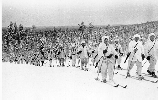Historical Highlights of Finland 
1155 The first missionaries arrive in Finland from Sweden. Finland becomes part of the Swedish realm.
1809-99 Sweden surrenders Finland to Russia. The Czar declares Finland a semi-autonomous Grand Duchy with himself as constitutional monarch represented by a governor general. Finland prospers under the extensive autonomy and more liberal conditions than in the rest of Russian Empire, with its own Senate and its own Diet, its own local officials, legislation, army, money (the mark) and postage stamps and an official border to Russia. National identity and nationalism awakens.
1812 Helsinki becomes capital, replacing the old - and more Swedish-oriented capital Turku.
1863 Finnish becomes, alongside with Swedish and Russian, an official administrative language.
1870-1910 "The golden period" in Finnish literature and arts.
1899 Russia starts its Russification policy against Finland with the so called "February manifesto". After the initial shock and disbelief, a well-organized passive resistance follows in Finland.
1906 Finnish women receive the right to vote and to run for parliament. Finland was the first country in Europe (and second in the world, after New Zealand) to grant women an equal right to vote in elections.
1917 As Russia plunges into the chaos of the October Revolution, Finland seizes the opportunity and declares independence from Russia on December 6.
1919 The present constitution is adopted and Finland becomes a republic with a president as head of state.

Finnish Soldiers at WW2
1941-44 The Continuation War. Finland attacks the Soviet Union at the same times as Germany, hoping to regain the lost areas, but eventually has to accept the borders of 1940 and, and also cede Pechenga, lease Porkkala peninsula as a military base for 50 years and pay war reparations. Despite losing the war, Finland was never occupied and it preserved its independence and sovereignty.
1944-48 "Years of Danger". Finland is afraid of a communist takeover.
1950's-80's "Finlandization" era. Finland remains an independent western European democracy, but at the same time has to be careful not to offend its eastern neighbour. Finland turns from a predominantly agrarian state into an urban one almost "overnight" and builds its welfare services.
1995 Finland becomes a member of the European Union.